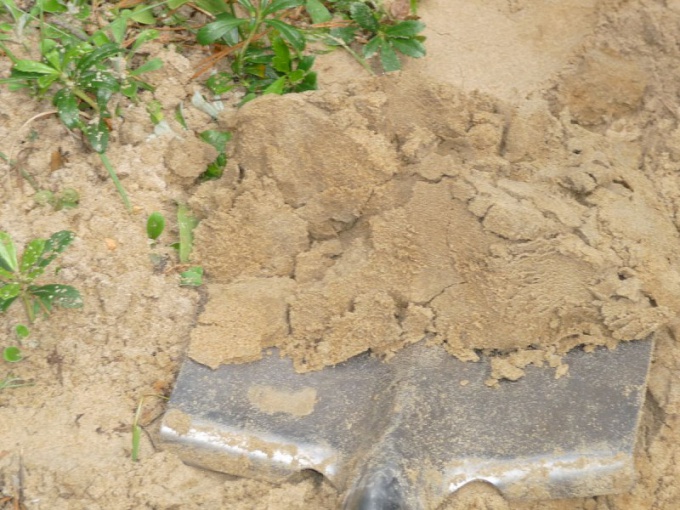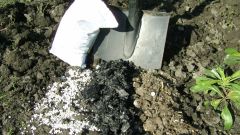Sandy soil may consist of more than 90% of sand that creates a lot of problems for gardeners. The sand during the day can become extremely hot, causing burns to the plants root system and constant lack of water and nutrients. In winter the soils freeze deeply and is able to destroy the roots of fruit trees. To avoid this problem, you can help improve the structure of soil and increase its ability to water retention.
The most simple, easy but lengthy method of cultivation of sandy soils is the application of organic fertilizers in large quantity. For every square meter of land should have about two buckets of manure, peat or garden compost. To make organics need quite a long time – for 2-3 years.
Increase organic matter in the soil can be achieved by planting plants of green manure: legumes, peas, lupine, white mustard, oilseed radish, etc. In the autumn the soil is dug up along with sloping, but not removed green manure plants that will prevent erosion from the land of nutrients and fill it with nitrogen, sulfur, and phosphorus. The process of digestion of plants in the sand is much faster than in the more fertile types of soil, which positively affects the structure and soil water content.
The first sign of improving sandy soil is the appearance of earthworms required for loosening and enriching the soil in humus. To keep the worms in the area, it's important to feed them with plant remains collected in the compost pile.
A more time consuming process improve the condition of sandy soil is its panowanie, which leads to increased capacity and ability of soil to accumulate nutrients. Clay soil is used only high-quality and necessarily in powder form. One square meter of area shall be at least two buckets of clay powder. The claying procedure is carried out for 4-5 years. If the process of turning sandy soil to sandy loam should be reduced to two seasons, will require the introduction of increased doses of clay powder to four buckets per square meter.
For example the option of improving the soil by sprinkling a thick layer of peat on top made of clay. The height of the peat layer should be at least 10 cm therefore, the area formed a new layer of soil, suitable for growing and successful fruiting of plants.
To raise the fertility and water-holding properties of sandy soils can make it lake silt. It quickly decomposes, and is a turnkey organic fertilizer. Sludge can add to the soil any time of the year when you are digging. Dose of this natural fertilizer is about 7-8 kg per square meter. Il does not require pre-composting, comparable to the effectiveness of the manure, its validity as fertilizer lasts about 3-4 years.
In the company improve the structure of sandy soils, it is important not to forget to mulch during the warmer time of the year to reduce the amount of evaporated moisture. During the preparation phase for the winter, the soil is thoroughly watered, which allows to increase its capacity and keep the plants from winter freezing.
The most simple, easy but lengthy method of cultivation of sandy soils is the application of organic fertilizers in large quantity. For every square meter of land should have about two buckets of manure, peat or garden compost. To make organics need quite a long time – for 2-3 years.
Increase organic matter in the soil can be achieved by planting plants of green manure: legumes, peas, lupine, white mustard, oilseed radish, etc. In the autumn the soil is dug up along with sloping, but not removed green manure plants that will prevent erosion from the land of nutrients and fill it with nitrogen, sulfur, and phosphorus. The process of digestion of plants in the sand is much faster than in the more fertile types of soil, which positively affects the structure and soil water content.
The first sign of improving sandy soil is the appearance of earthworms required for loosening and enriching the soil in humus. To keep the worms in the area, it's important to feed them with plant remains collected in the compost pile.
A more time consuming process improve the condition of sandy soil is its panowanie, which leads to increased capacity and ability of soil to accumulate nutrients. Clay soil is used only high-quality and necessarily in powder form. One square meter of area shall be at least two buckets of clay powder. The claying procedure is carried out for 4-5 years. If the process of turning sandy soil to sandy loam should be reduced to two seasons, will require the introduction of increased doses of clay powder to four buckets per square meter.
For example the option of improving the soil by sprinkling a thick layer of peat on top made of clay. The height of the peat layer should be at least 10 cm therefore, the area formed a new layer of soil, suitable for growing and successful fruiting of plants.
To raise the fertility and water-holding properties of sandy soils can make it lake silt. It quickly decomposes, and is a turnkey organic fertilizer. Sludge can add to the soil any time of the year when you are digging. Dose of this natural fertilizer is about 7-8 kg per square meter. Il does not require pre-composting, comparable to the effectiveness of the manure, its validity as fertilizer lasts about 3-4 years.
In the company improve the structure of sandy soils, it is important not to forget to mulch during the warmer time of the year to reduce the amount of evaporated moisture. During the preparation phase for the winter, the soil is thoroughly watered, which allows to increase its capacity and keep the plants from winter freezing.

